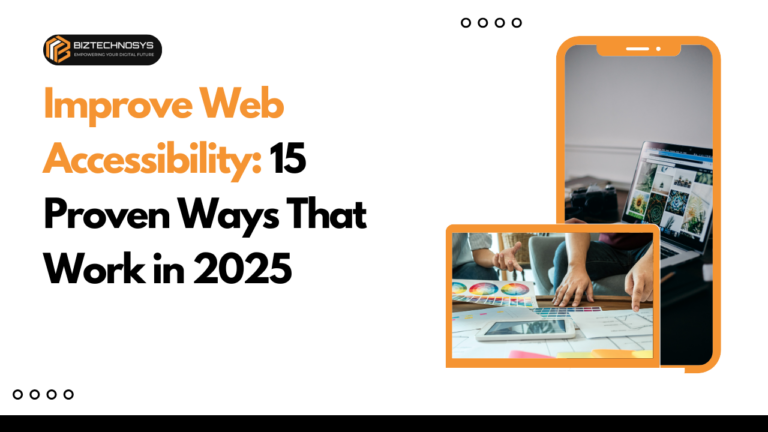
Creating an inclusive digital environment isn’t just a matter of good ethics — it’s a necessity. Let’s explore the three core reasons why organizations and developers should improve web accessibility.
Making your website accessible ensures that people with disabilities can navigate, interact, and benefit from your digital content. This fosters a more inclusive society where everyone has equal access to online resources. The use of AI data analytics and customer data platforms can even help identify pain points for these users and improve their experience.
Accessible websites reach a wider audience, including over 1 billion people with disabilities worldwide. By improving accessibility, businesses tap into a larger customer base, increasing potential revenue. Tools like digital asset management and AI for data analysis can help in tracking engagement and optimizing web strategies
Failing to meet accessibility standards can lead to legal consequences. Adhering to accessibility laws such as the Americans with Disabilities Act (ADA) or WCAG guidelines ensures your business stays compliant and avoids costly lawsuits. Companies listed in Gartner Magic Quadrant Customer Data Platform often prioritize accessibility in their platforms.
Continue reading about How much does Sitecore cost? with this link.
Web accessibility is built around four core principles known as POUR:
Perceivable: Information must be presentable to users in ways they can perceive (e.g., text alternatives for images).
Operable: UI components must be operable through a keyboard or other input methods.
Understandable: Content must be readable and predictable.
Robust: Content must be compatible with various assistive technologies.
AI tools for data analysis and AI data analytics tools help test these principles across different platforms to ensure compliance.
Making a website accessible involves multiple strategies like improving site navigation, optimizing contrast, and ensuring content readability. Integrating a customer data platform (CDP) can help tailor experiences for users based on accessibility needs. Platforms recognized in Forrester Wave Digital Experience Platforms often come with built-in accessibility features.
Continue reading about What is Sitecore Content Hub One? with this link.
To enhance web accessibility means to make incremental or structural improvements to a website’s design, content, or technical architecture to support users with various disabilities. This can include using AI marketing tools to auto-generate alt text, or email marketing AI to ensure accessible email templates.
Web accessibility means that websites, tools, and technologies are designed and developed so that people with disabilities can use them. It involves designing for all types of impairments—visual, auditory, cognitive, neurological, physical, and speech-related. Gartner Magic Quadrant for Digital Experience Platforms often evaluates these aspects.
Disabilities can affect how users interact with websites in many ways:
Visual impairments may prevent users from seeing images or reading small text.
Motor impairments can make it difficult to use a mouse.
Hearing impairments may hinder understanding of audio content.
Cognitive disabilities may affect focus and understanding.
Using AI analytics tools and predictive AI, developers can understand how to better support such users.
Continue reading about What is Sitecore 360? How Can It Benefit Your Business? with this link
Make videos accessible by adding captions and transcripts. This also helps with automating data analysis using artificial intelligence by making content searchable.
Ensure sufficient contrast between text and background so it’s readable for users with low vision.
Avoid content that flickers or flashes to prevent seizures or motion sensitivity.
Proper use of headings helps screen readers interpret content structure better.
Cluttered designs confuse users with cognitive disabilities. Simplicity aids understanding.
Describe images accurately for screen reader users. Tools from AI marketing platforms can auto-generate these descriptions.
Forms should be clearly labeled so assistive technologies can guide users effectively.
Continue reading about How to Choose a Sitecore Development Partner with this link.
Use accessible CAPTCHA options like image selection or audio alternatives.
Ensure all functionalities can be accessed via keyboard for users with motor disabilities.
Give users extra time to complete tasks like filling forms, especially helpful for those with cognitive issues.
Use tables only for tabular data. CSS should be used for layout to maintain accessibility.
Instead of using “click here,” provide descriptive text like “Download the report.” This helps users understand the link’s purpose.
Instead of using “click here,” provide descriptive text like “Download the report.” This helps users understand the link’s purpose.
Skip links help users jump directly to main content, bypassing repetitive elements like navigation menus.
Continue reading about Ace Your Holiday Email Campaigns with Sitecore Personalization with this link.
Provide alternatives such as email, phone, and chat to accommodate different user preferences.
Regularly test using tools and AI platforms. Integrating with customer data platform vendors and marketing data platforms can provide insights into accessibility gaps.
Accessibility isn’t just about compliance—it’s about empathy, inclusivity, and innovation. Leveraging modern tools like AI for data analytics, Gartner customer data platform, and CMS Magic Quadrant rated systems can ensure that your site is inclusive, welcoming, and impactful.
An accessible website enhances user experience, broadens your reach, and fosters brand loyalty. Businesses that invest in accessibility not only improve usability for all but also gain a competitive edge in the digital world.
Including web accessibility as a key focus alongside CDP and marketing automation, segment data platforms, and AI tools for data analysis ensures your digital presence is future-proof and user-centered. Now is the time to enhance web accessibility and make the internet a better place for everyone.
Continue reading about The Role of AI in Sitecore Marketing Tools with this link.

We are your Strategic IT Partner in development of reliable and scalable IT solutions for any OS, browser and device. We bring together deep industry expertise and the latest IT advancements to deliver custom solutions and products that perfectly fit the needs and behavior of your target audience.
Skype :: biztechnosys
AUS :: +61 4684 88455
INDIA :: +918035827097
Email :: info@biztechnosys.com
Copyright © 2012 – 2025 BIZTECHNOSYS. All Rights Reserved.